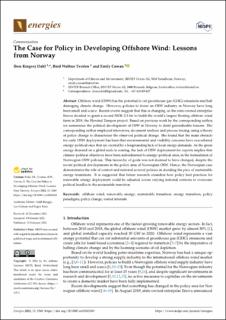| dc.contributor.author | Ringvej Dahl, Iben | |
| dc.contributor.author | Tveiten, Bård Wathne | |
| dc.contributor.author | Cowan, Emily Christine | |
| dc.date.accessioned | 2022-09-08T09:37:25Z | |
| dc.date.available | 2022-09-08T09:37:25Z | |
| dc.date.created | 2022-03-07T09:31:24Z | |
| dc.date.issued | 2022 | |
| dc.identifier.citation | Energies. 2022, 15 (4), 1-14. | en_US |
| dc.identifier.issn | 1996-1073 | |
| dc.identifier.uri | https://hdl.handle.net/11250/3016546 | |
| dc.description.abstract | Offshore wind (OSW) has the potential to cut greenhouse gas (GHG) emissions and halt damaging climate change. However, policies to foster an OSW industry in Norway have long been small and scarce. Recent events suggest that this is changing, as the state-owned enterprise Enova decided to grant a record NOK 2.3 bn to build the world’s largest floating offshore wind farm in 2019, the Hywind Tampen project. Based on previous work by the corresponding author, we summarize the political development of OSW in Norway to distil generalisable lessons. The corresponding author employed interviews, document analysis and process tracing, using a theory of policy change to characterise the observed political change. She found that the main obstacle for early OSW deployment has been that environmental and visibility concerns have exacerbated energy–political ones that are created by a longstanding lack of local energy demands. As the green energy demand on a global scale is soaring, the lack of OSW deployment for exports implies that climate–political objectives have been subordinated to energy–political ones, in the formulation of Norwegian OSW policies. This hierarchy of goals was not deemed to have changed, despite the recent political developments in the policy area of Norwegian OSW. Hence, the Norwegian case demonstrates the role of context and national sectoral policies in deciding the pace of sustainable energy transitions. It is suggested that future research considers how policy best practices for renewable energy deployment could be adjusted across varying national contexts to overcome political hurdles to the sustainable transition. | en_US |
| dc.language.iso | eng | en_US |
| dc.publisher | MDPI | en_US |
| dc.rights | Navngivelse 4.0 Internasjonal | * |
| dc.rights.uri | http://creativecommons.org/licenses/by/4.0/deed.no | * |
| dc.subject | vested interests | en_US |
| dc.subject | policy change | en_US |
| dc.subject | policy paradigms | en_US |
| dc.subject | energy transition | en_US |
| dc.subject | sustainable transition | en_US |
| dc.subject | renewable energy | en_US |
| dc.subject | offshore wind | en_US |
| dc.title | The Case for Policy in Developing Offshore Wind: Lessons from Norway | en_US |
| dc.title.alternative | The Case for Policy in Developing Offshore Wind: Lessons from Norway | en_US |
| dc.type | Peer reviewed | en_US |
| dc.type | Journal article | en_US |
| dc.description.version | publishedVersion | en_US |
| dc.rights.holder | Copyright: © 2022 by the authors. Licensee MDPI, Basel, Switzerland. This article is an open access article distributed under the terms and conditions of the Creative Commons Attribution (CC BY) license (https:// creativecommons.org/licenses/by/ 4.0/). | en_US |
| dc.source.pagenumber | 1-14 | en_US |
| dc.source.volume | 15 | en_US |
| dc.source.journal | Energies | en_US |
| dc.source.issue | 4 | en_US |
| dc.identifier.doi | 10.3390/en15041569 | |
| dc.identifier.cristin | 2007919 | |
| cristin.ispublished | true | |
| cristin.fulltext | original | |
| cristin.qualitycode | 1 | |

